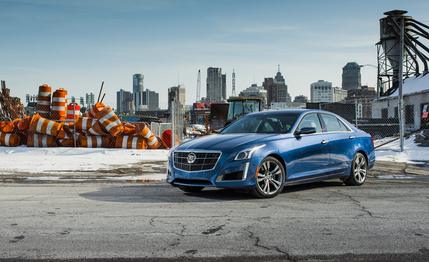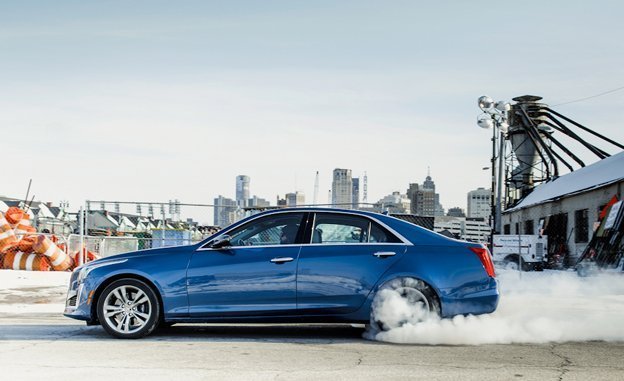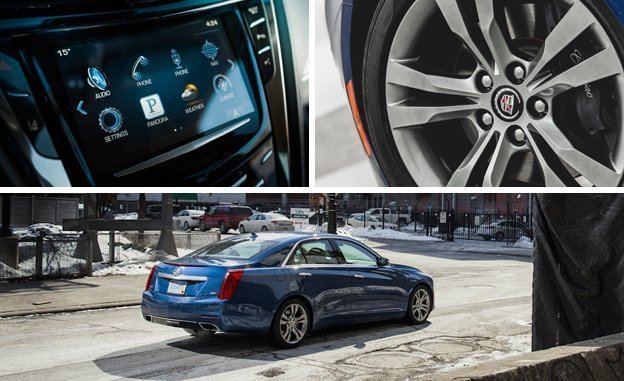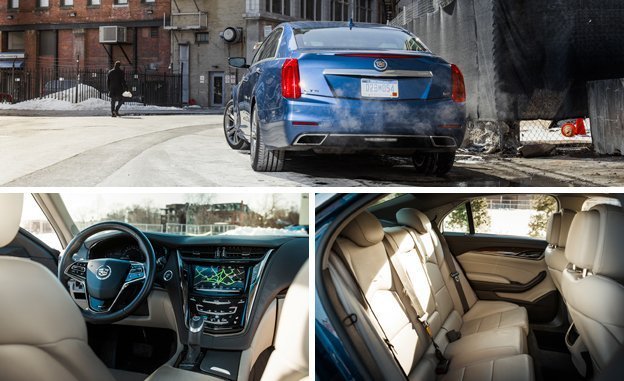
 Long-Term Road Test Wrap-Up
From the June 2015 issue
Long-Term Road Test Wrap-Up
From the June 2015 issue
In 2014, Cadillac poached, from Infiniti, one of the auto industry’s most celebrated and outspoken execs. It also showed the 464-hp ATS-V and the 640-hp CTS-V, and said that it will be renaming its lineup using designations beginning with either CT (cars) or XT (trucks) followed by a number. But nothing it did generated more hand-wringing than the brand’s announcement that it was moving its headquarters from Detroit to New York City.
Chief among the justifications for the move was to physically separate Cadillac from the rest of General Motors, the better to foster a distinct product portfolio. But that process is already underway. Cadillac’s ATS and the new CTS boast a segment-defining excellence absent in many GM products. Introduced for the 2014 model year, the third-generation CTS—particularly in 420-hp, twin-turbo 3.6-liter V-6–bearing Vsport trim—is a sports sedan of singular focus. Ultra-high-definition feedback streams through the steering, the chassis reacts like that of a 14/10-scale BMW E30, and the engine hurtles the car forward with smoothness and sonorousness heretofore reserved for sixes of the straight Bavarian variety, not bent American ones. We named the CTS to our 10Best list for 2014 and 2015, ordering up a long-termer in between the handoff of the two trophies.
For its 40,000-mile stay, we naturally opted for the $59,995 Vsport, but stopped there, without adding any options. The car comes standard with important mechanical bits such as adaptive magnetorheological shocks, an electronically controlled limited-slip differential, and Brembo brakes. A third zone for the dual-zone climate control or 20-way adjustable seats just seemed like unnecessary embellishments.
And the Vsport impressed right out of the box, sticking to the skidpad at 0.95 g and stopping from 70 mph in just 155 feet—bona fide supersedan numbers. The last BMW M5 we tested couldn’t match either of those figures, and while the lighter M3 manages higher cornering grip, it beats the Vsport’s stopping distance by only two feet. And with two Mitsubishi turbos squeezing 15 psi into the intake, the overachieving 3.6 pushed the CTS to 60 mph in 4.6 seconds, through the quarter-mile in 13.1 at 110 mph, and up to a 171-mph terminal velocity.


We’ll admit to some skepticism and maybe even a little bit of eye rolling when we first heard the output figures for the CTS’s twin-turbo V-6: 420 horsepower at 5750 rpm and 430 pound-feet at 3500. General Motors is not a house renowned for its mastery of turbocharging, and it has a long history of V-6s ranging from humdrum on their best days to dreadful on their worst. But this engine is something entirely different. The torque comes on low and stays so strong throughout the rev range that the 6500-rpm-redline upshifts feel premature. And the sound, enhanced as it is in the style of the day through the audio system’s speakers, is pure sports-car warble. In the same breath—okay, the same press release—as it announced its move to the isle of Manhattan, GM also announced that Cadillac would be reorganized as a separate business unit. That means more autonomy and greater separation from the goings-on in the silvery monolith. And it means more brand-specific engines like this one. New president Johan de Nysschen has already spilled the beans on the twin-turbo V-8 in Cadillac’s future.
Not that the six couldn’t use more massaging. The CTS overlapped our long-term 2013 Audi S7 early in its billet, and the similarities between the two vehicles were hard to ignore. Not just that both were blue luxury cars, but that both had turbocharged engines making 420 horsepower, though the Audi had two more cylinders and an extra 429 cubic centimeters of displacement. It showed in the way the two engines make their power. Under wide-open throttle, both are eye-opening. But in only moderately aggressive driving, Audi’s 4.0-liter V-8 is rheostat smooth, making it easy to dial up precisely the output you demand. The Cadillac, on the other hand, tends to answer middling throttle prods with a slightly embarrassing American boisterousness. Give it half-throttle, and the engine responds as though you’ve floored it. The transmission, too, tugs on the reins, effecting seamless handoffs from ratio to ratio under full throttle but not chilling out quite enough under partial juicing. With all but the lightest throttle applications, shifts are surprisingly harsh. We also noted a disconcertingly rough idle, particularly when the engine was cold, though the ECU was never so bothered by it to throw any trouble codes.
And yet, we did find ourselves at the dealership early on. Just 8700 miles into the CTS’s stay, a front-end rattle sent us to the service desk. Technicians found prematurely worn anti-roll-bar end links, which they replaced under warranty. Cadillac’s Premium Care Maintenance program covered our five oil changes and inspections, but it doesn’t cover things such as wiper blades ($48) or a wheel alignment ($90).
Tires were a bigger problem. We replaced the fronts after rolling 15,216 miles and the rears shortly thereafter, for a total cost of $1407, but someone else’s tire cost us even more. At 27,560 miles, the Vsport got slapped in the face by a chunk of estranged truck tread, prompting $5971 in repairs and a lecture from Alterman on appropriate following distances. Included in the bill: a new hood ($895), bumper cover ($595), headlight assembly ($1250), and driving light ($238). Then, at 37,070 miles, replacing a cracked windshield appropriated another $673 from our Save the Manuals! super-PAC fund.

 We never warmed to the CUE infotainment system. We like the CTS's sophisticated styling, but it makes the wheels look small.
We never warmed to the CUE infotainment system. We like the CTS's sophisticated styling, but it makes the wheels look small.
We would pay for CUE, Cadillac’s deservedly maligned infotainment system, with our patience. Rarely has anything inspired such universal loathing among our staff. Prior experience told us that we would be searching to find nice things to say about it, but we didn’t realize what a futile effort that would be. If you start with contempt, what does familiarity breed? In our case, it was lots of red-faced moments at the wheel and solitary screaming. We may have appeared to other motorists to be anger-management candidates, furiously mouthing obscenities, but that’s only because in the presence of CUE, well, we were. Its slow reaction time, confounding menu structure, and distracting touch-screen interface were only the beginning.
We posit that CUE was conceived on a preliminary expedition to New York—it’s so cosmopolitan, it can’t be bothered with middle America. On two separate Midwestern excursions, it lost track of where it was, once believing the highway we were on to be nonexistent, showing the car in the middle of a field for a good half-hour. And in Michigan’s upper peninsula, it routinely overestimated travel times by absurd intervals, sometimes by a factor of two. It was also unaware of many roads, or was aware of them but didn’t realize they were one-way. That last one is a potentially catastrophic oversight, unacceptable now that we’re a good decade beyond that type of mistake being commonplace. Sure, CUE makes for a sleek dash design, but form over function on this scale should be a cardinal sin—well, unless you’re Apple. Pointing out how the “back” button moves around the screen depending on which menu is displayed, features editor Jeff Sabatini noted, “This is Interface Design 101 stuff, and GM has completely failed.”
And yet, we can forgive the inordinate annoyance triggered by these features in the grand scheme of things. Cadillac has spent the last 13 years making steady and marked improvements to the CTS, and we have rewarded the car with a spot on our 10Best list seven of those years. This latest version is so good at its core, delivering outsized and increasingly rare doses of driver engagement and satisfaction, that we found ourselves liking the car more and more as the miles piled on. Oddly, fewer and fewer buyers seem to realize how good the CTS is. In 2014, this best-ever CTS hit an all-time low—just 31,115 sales.


Here’s the thing about that New York move: It won’t be all of Cadillac. Executives and marketing people are going to the Big Apple to immerse themselves, as GM says, “in a premium lifestyle.” But engineering and product development will remain in the Detroit area. So the people who have been responsible for making the CTS great will keep at it, while the ones responsible for telling people how great it is are heading east.
Detroit has always been a city of doers, New York a city of gabbers. Maybe this arrangement will work out after all.
Jeff Sabatini: Just once, I’d like to get in a GM car and say, “Wow, this is a lot nicer than it had to be.” But that may never happen.
Mike Sutton: Forget CUE and give me a damn knob.
Jennifer Harrington: The maps need to be updated. While on U.S. 24 in Ohio, CUE thought I was off-roading for 30 minutes and the road was nowhere in sight on the map.
Ron Sessions: The structural adhesives that GM uses at weld joints to glue each CTS together really pay off in stiffness; this is a very tight structure.
Carolyn Pavia-Rauchman: I’d vote for 100,000 miles in this sedan.
Tony Quiroga: Why doesn’t auto start turn on the heated seats and steering wheel? An annoying nit in an otherwise splendid sedan.
Juli Burke: Enjoy the quick, powerful engine. Despise CUE. Case closed.
Dave Beard: Collision alert had a few miscues. Roadkill set it off once.
Eric Tingwall: If you thought CUE was bad, try using it while wearing gloves.
K.C. Colwell: My 75-year-old father-in-law loved it. “You got a turbo in that?”
Alex Stoklosa: I love the engine note, which has the perfect combination of growl and volume.
Daniel Pund: Insanely small side mirrors on this compared with the elephant ears on European cars.